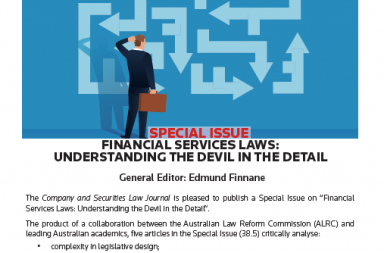*Please note that the links to the content in this Part will direct you to Westlaw AU. If you are still using Legal Online, the links can be found in the LOLA PDF at the bottom of this post.
The latest issue of the Criminal Law Journal (Volume 36 Part 6) contains the following material:
- Fair trial and prejudicial (social) media comment – the problem is not social media but the existing law
Articles
Constitutional perspectives on sentencing: Some challenging issues – Arie Freiberg and Sarah Murray
Constitutional challenges in the sentencing context have rarely been successful before Australian courts. This article seeks to explain why sentencing laws are so difficult to invalidate under Ch III of the Commonwealth Constitution. In tracing recent case developments using sentencing themes, the article suggests that the prime constitutional grounds which may succeed relate to instances where the essential nature or role of the court is compromised by a sentencing arrangement or legislative provision. However, beyond this ambit, Australian sentencing legislation is unlikely to be curbed by the constitutional dictates of Ch III.
To purchase this article, complete the Individual Article Sale order form and email it to [email protected].
The scope of the provocation defence and consent in Code jurisdictions – Toby Nisbet
This article examines provocation as a defence to grievous bodily harm. It is submitted that the decision in Kaporonovski v The Queen must be considered in light of the reasoning in Houghton v The Queen. All the High Court justices in Kaporonovski proceeded on the assumption that “unlawful†meant “not authorised justified or excusedâ€. Houghton indicates grievous bodily harm in s 297 of Western Australia’s Criminal Code has a further element, “unlawfulâ€, meaning “positively proscribed by lawâ€. Provoked assaults are not positively proscribed by law, and are therefore not “unlawfulâ€. Provocation is thus a defence to grievous bodily harm in Western Australia. The same logic probably applies to Queensland. Houghton has further implications for Code jurisdictions regarding consent to grievous bodily arising from sado-masochistic practices and tribal punishment. Embracing the reasoning in Houghton may be one way to give partial, formal, recognition to Indigenous Australian customary.
To purchase this article, complete the Individual Article Sale order form and email it to [email protected].
Affray: What is it, and what is it not? – Jane Sanders and Edward Elliott
Affray is a statutory offence provided for by s 93C of the Crimes Act 1900 (NSW). The intention of Parliament to make it a serious offence is indicated by the maximum penalty of 10 years’ imprisonment that it carries. Despite this, the authors’ experience is that the offence is used to criminalise otherwise minor antisocial conduct where other offences such as assault cannot be proved. This is in contrast to the history of the offence as a common law felony relating to serious disruptions of the peace and threats of harm to persons nearby. This article argues that the common law position is not lost in codification, and the continued use of affray as a prosecutorial tool against otherwise minor antisocial behaviour is outside the scope of the offence on any interpretation of the provision, and brings with it deleterious effects against which the utmost caution should be exercised.
To purchase this article, complete the Individual Article Sale order form and email it to [email protected].
Sentencing review 2011-2012 – Kate Warner
To purchase this article, complete the Individual Article Sale order form and email it to [email protected].
Sections
- Never to be released?
For the pdf version of the table of contents, click here:Â LOLA – Crim LJ Vol 36 Pt 6 Contents or here:Â WAU – Crim LJ Vol 36 Pt 6 Contents.

